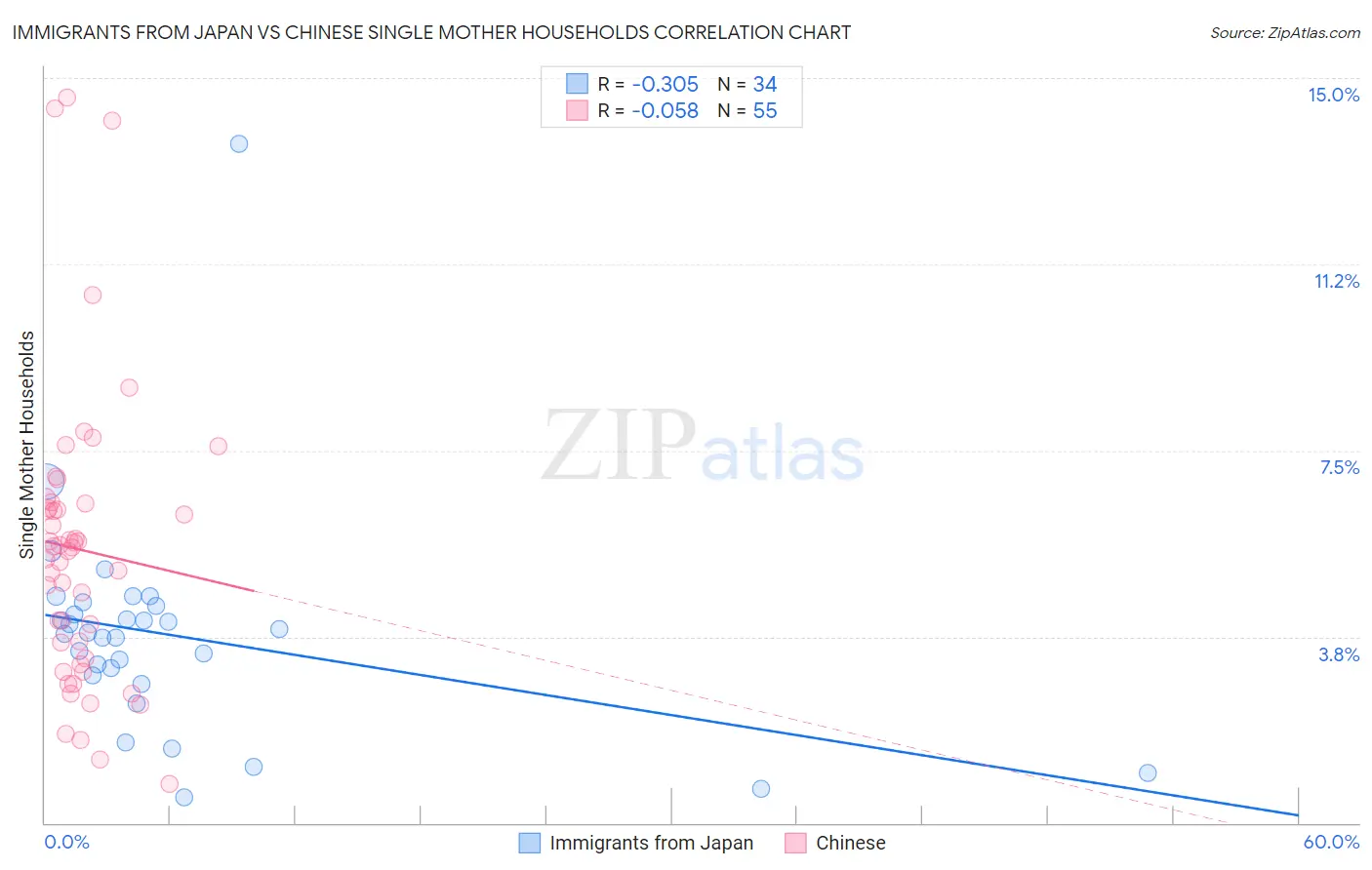Immigrants from Japan vs Chinese Single Mother Households
COMPARE
Immigrants from Japan
Chinese
Single Mother Households
Single Mother Households Comparison
Immigrants from Japan
Chinese
5.2%
SINGLE MOTHER HOUSEHOLDS
99.8/ 100
METRIC RATING
25th/ 347
METRIC RANK
5.2%
SINGLE MOTHER HOUSEHOLDS
99.9/ 100
METRIC RATING
19th/ 347
METRIC RANK
Immigrants from Japan vs Chinese Single Mother Households Correlation Chart
The statistical analysis conducted on geographies consisting of 339,363,268 people shows a mild negative correlation between the proportion of Immigrants from Japan and percentage of single mother households in the United States with a correlation coefficient (R) of -0.305 and weighted average of 5.2%. Similarly, the statistical analysis conducted on geographies consisting of 64,782,861 people shows a slight negative correlation between the proportion of Chinese and percentage of single mother households in the United States with a correlation coefficient (R) of -0.058 and weighted average of 5.2%, a difference of 1.7%.

Single Mother Households Correlation Summary
| Measurement | Immigrants from Japan | Chinese |
| Minimum | 0.51% | 0.78% |
| Maximum | 13.7% | 14.6% |
| Range | 13.2% | 13.8% |
| Mean | 3.8% | 5.5% |
| Median | 3.8% | 5.5% |
| Interquartile 25% (IQ1) | 3.0% | 3.3% |
| Interquartile 75% (IQ3) | 4.4% | 6.4% |
| Interquartile Range (IQR) | 1.4% | 3.1% |
| Standard Deviation (Sample) | 2.2% | 2.9% |
| Standard Deviation (Population) | 2.2% | 2.9% |
Demographics Similar to Immigrants from Japan and Chinese by Single Mother Households
In terms of single mother households, the demographic groups most similar to Immigrants from Japan are Immigrants from Lithuania (5.3%, a difference of 0.030%), Armenian (5.2%, a difference of 0.34%), Immigrants from Austria (5.2%, a difference of 0.39%), Thai (5.2%, a difference of 0.44%), and Bhutanese (5.3%, a difference of 0.54%). Similarly, the demographic groups most similar to Chinese are Immigrants from Armenia (5.2%, a difference of 0.11%), Maltese (5.2%, a difference of 0.47%), Eastern European (5.2%, a difference of 0.53%), Soviet Union (5.1%, a difference of 0.88%), and Indian (Asian) (5.1%, a difference of 1.1%).
| Demographics | Rating | Rank | Single Mother Households |
| Cypriots | 99.9 /100 | #12 | Exceptional 5.1% |
| Immigrants | India | 99.9 /100 | #13 | Exceptional 5.1% |
| Immigrants | Australia | 99.9 /100 | #14 | Exceptional 5.1% |
| Immigrants | Eastern Asia | 99.9 /100 | #15 | Exceptional 5.1% |
| Indians (Asian) | 99.9 /100 | #16 | Exceptional 5.1% |
| Soviet Union | 99.9 /100 | #17 | Exceptional 5.1% |
| Immigrants | Armenia | 99.9 /100 | #18 | Exceptional 5.2% |
| Chinese | 99.9 /100 | #19 | Exceptional 5.2% |
| Maltese | 99.9 /100 | #20 | Exceptional 5.2% |
| Eastern Europeans | 99.8 /100 | #21 | Exceptional 5.2% |
| Thais | 99.8 /100 | #22 | Exceptional 5.2% |
| Immigrants | Austria | 99.8 /100 | #23 | Exceptional 5.2% |
| Armenians | 99.8 /100 | #24 | Exceptional 5.2% |
| Immigrants | Japan | 99.8 /100 | #25 | Exceptional 5.2% |
| Immigrants | Lithuania | 99.8 /100 | #26 | Exceptional 5.3% |
| Bhutanese | 99.7 /100 | #27 | Exceptional 5.3% |
| Russians | 99.7 /100 | #28 | Exceptional 5.3% |
| Latvians | 99.7 /100 | #29 | Exceptional 5.3% |
| Burmese | 99.7 /100 | #30 | Exceptional 5.3% |
| Immigrants | Korea | 99.7 /100 | #31 | Exceptional 5.3% |
| Cambodians | 99.7 /100 | #32 | Exceptional 5.3% |